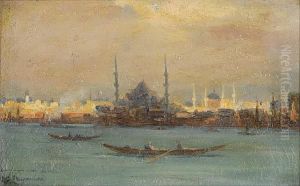Sarkis Erganian Paintings
Sarkis Erganian, born in 1870 in Kayseri, Ottoman Empire, is a figure whose artistic journey spans continents, reflecting a rich tapestry of cultural and historical influences. Erganian's early life in the Ottoman Empire, amidst its diverse and layered societies, provided a vibrant backdrop that influenced his artistic vision. His Armenian heritage, coupled with the cosmopolitan environment of the late Ottoman period, infused his work with a unique blend of Eastern and Western artistic traditions. Erganian's migration to the United States in the early 20th century marked a new chapter in his life and career, embedding him within the burgeoning Armenian diaspora community and the wider American art scene.
Erganian's oeuvre is notable for its eclectic range, encompassing landscapes, portraits, and religious themes. His landscapes, often inspired by his Armenian homeland and his travels, are imbued with a sense of nostalgia and loss, reflecting the broader Armenian experience of displacement following the genocide of 1915. Erganian's portraits, on the other hand, capture the essence of his subjects with depth and sensitivity, showcasing his ability to transcend cultural and linguistic barriers through art. His religious works, deeply rooted in the Armenian Christian tradition, reveal a profound spirituality and a connection to the ancient heritage of his people.
Throughout his career, Erganian exhibited his work in various venues, from local community centers to more prestigious galleries and museums in the United States and abroad. His contributions to the art world were recognized by his contemporaries, and his legacy continues to be celebrated by the Armenian diaspora and art historians alike. Erganian's life and work embody the resilience and adaptability of the Armenian spirit, making him an important figure in the annals of Armenian and American art history. He passed away in 1950, leaving behind a body of work that continues to inspire and captivate audiences with its beauty, emotional depth, and cultural significance.

